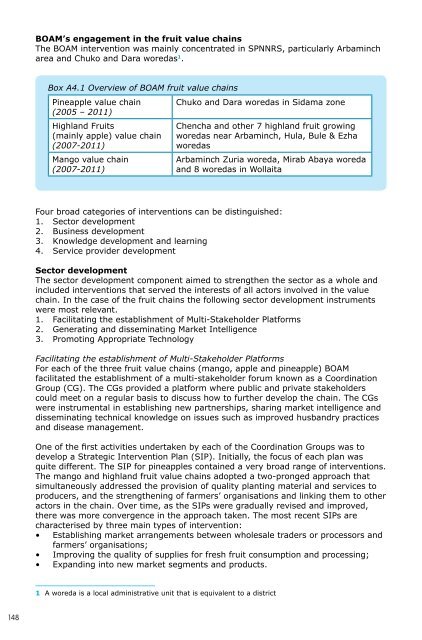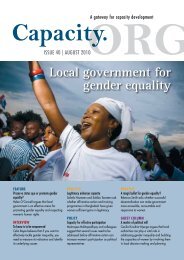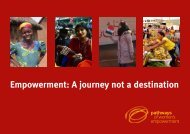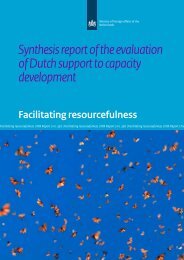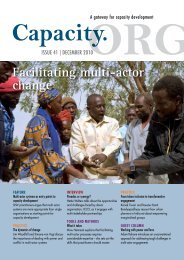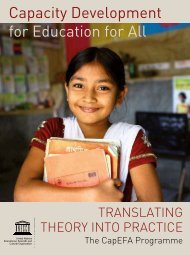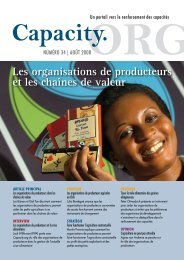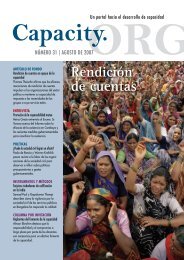Pro-Poor Value Chain Development - Capacity.org
Pro-Poor Value Chain Development - Capacity.org
Pro-Poor Value Chain Development - Capacity.org
Create successful ePaper yourself
Turn your PDF publications into a flip-book with our unique Google optimized e-Paper software.
148<br />
BOAM’s engagement in the fruit value chains<br />
The BOAM intervention was mainly concentrated in SPNNRS, particularly Arbaminch<br />
area and Chuko and Dara woredas 1 .<br />
Box A4.1 Overview of BOAM fruit value chains<br />
Pineapple value chain<br />
(2005 – 2011)<br />
Highland Fruits<br />
(mainly apple) value chain<br />
(2007-2011)<br />
Mango value chain<br />
(2007-2011)<br />
Chuko and Dara woredas in Sidama zone<br />
Chencha and other 7 highland fruit growing<br />
woredas near Arbaminch, Hula, Bule & Ezha<br />
woredas<br />
Arbaminch Zuria woreda, Mirab Abaya woreda<br />
and 8 woredas in Wollaita<br />
Four broad categories of interventions can be distinguished:<br />
1. Sector development<br />
2. Business development<br />
3. Knowledge development and learning<br />
4. Service provider development<br />
Sector development<br />
The sector development component aimed to strengthen the sector as a whole and<br />
included interventions that served the interests of all actors involved in the value<br />
chain. In the case of the fruit chains the following sector development instruments<br />
were most relevant.<br />
1. Facilitating the establishment of Multi-Stakeholder Platforms<br />
2. Generating and disseminating Market Intelligence<br />
3. <strong>Pro</strong>moting Appropriate Technology<br />
Facilitating the establishment of Multi-Stakeholder Platforms<br />
For each of the three fruit value chains (mango, apple and pineapple) BOAM<br />
facilitated the establishment of a multi-stakeholder forum known as a Coordination<br />
Group (CG). The CGs provided a platform where public and private stakeholders<br />
could meet on a regular basis to discuss how to further develop the chain. The CGs<br />
were instrumental in establishing new partnerships, sharing market intelligence and<br />
disseminating technical knowledge on issues such as improved husbandry practices<br />
and disease management.<br />
One of the first activities undertaken by each of the Coordination Groups was to<br />
develop a Strategic Intervention Plan (SIP). Initially, the focus of each plan was<br />
quite different. The SIP for pineapples contained a very broad range of interventions.<br />
The mango and highland fruit value chains adopted a two-pronged approach that<br />
simultaneously addressed the provision of quality planting material and services to<br />
producers, and the strengthening of farmers’ <strong>org</strong>anisations and linking them to other<br />
actors in the chain. Over time, as the SIPs were gradually revised and improved,<br />
there was more convergence in the approach taken. The most recent SIPs are<br />
characterised by three main types of intervention:<br />
• Establishing market arrangements between wholesale traders or processors and<br />
farmers’ <strong>org</strong>anisations;<br />
• Improving the quality of supplies for fresh fruit consumption and processing;<br />
• Expanding into new market segments and products.<br />
1 A woreda is a local administrative unit that is equivalent to a district


